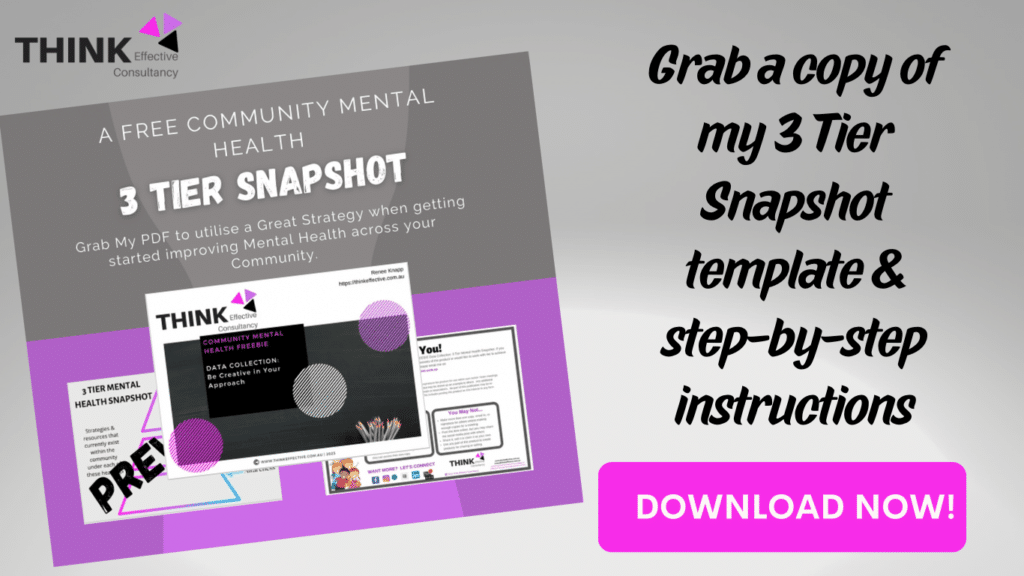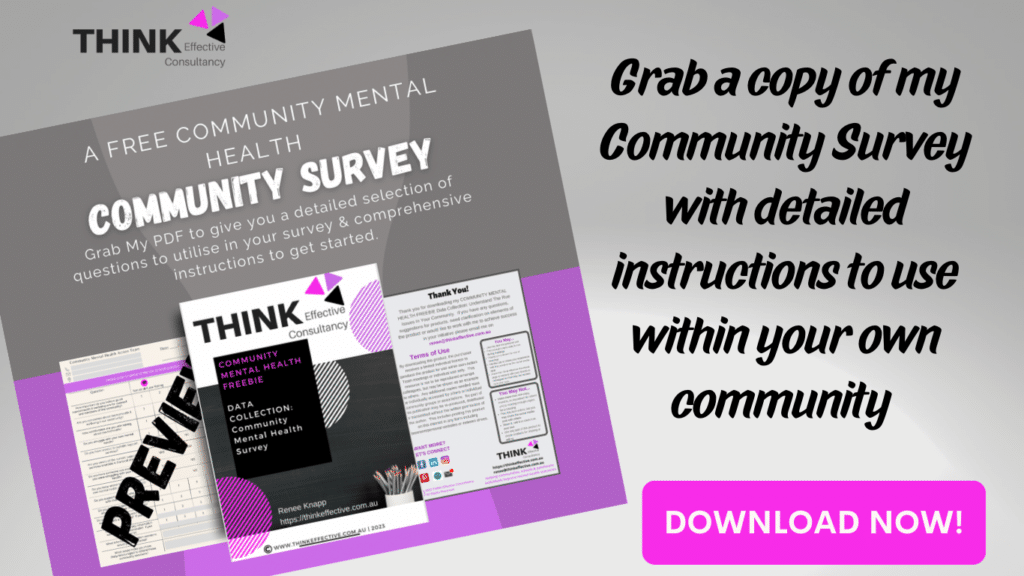So hopefully now you have a good understanding of the benefits of data and an understanding of the importance of making data practical, engaging and meaningful after reading my last post on Data Collection: Reasons For & What To Collect
Today I am going to go through some specific strategies that you can use to collect community mental health data in more detail. I will explain the process for each and you can download the FREE resource available on this post to get started with your action team.
Whilst there are many strategies that I can suggest for data collection, I am going to talk about 2 specific strategies that are great to start using immediately and are fairly easy to implement.
A place to start when you have formed your action team it to collect a 3 Tier Snapshot. This involves collecting information on what is currently happening across the community in mental health with regards to
The team can start to identify these things but this provides a great oppportunity for the team to either get out and chat to the community about what is happening or send a series of questions to organisations/businesses to ask them what they currently do in each space.
STEP 1 Brainstorm as a team what you think is currently being done in each area across the community
STEP 2 Decide as a team how to get more information from the community to feed into the Tiered Diagram
STEP 3 If choosing to collect information informally through conversations, allocate each member of the team a group of organisations and set a timeframe for data collection. Team members go to each organisation and ask them 3 questions eg. “What do currently do in your organisation to raise awareness of mental health and issues?”
STEP 4 If collecting information formally through online questions, use a platform such as Microsoft Forms or Survey Monkey to send out to organisations. This will collate the information for you. However the challenge with this is to make a plan to follow up to ensure you receive forms or surveys back.
STEP 5 Collate information and add to 3 Tier Diagram. Share this information with community as a snapshot of current practices in mental health. It is a great starting point for conversations and goal setting.
# You can also complete a similar activity with protective (reduce the likelihood of poor mental health) and risk factors (increase the likelihood of poor mental health) in your local community.

We have to be careful with surveys as people are time poor and will often overlook a survey when it is sent with completion rates often very disappointing. However if we add a little creativity we can get surprisingly good results.
STEP 1 As an action team consider what questions to include on your survey?
(Download free resource below for a selection of sample questions to ask in survey)
STEP 2 Launch survey on social media, in person, via email and through any other available platforms. Do this rather than just adding it on with little consideration.
STEP 3 Ensure that you include schools in the survey. If possible ask someone within the school to carry out the survey at a staff meeting/during classes to ensure that all staff and students have a chance to complete the survey
STEP 4 Break survey into individual questions to ask on social media or as a slip to hand out at large gatherings with a ballot type box for collection.
STEP 5 Ask local businesses for a prize donation to use for the first survey completed or a random drawer for anyone who completes the survey
STEP 6 Ask govt organisations for data that may be useful to action team in decision making.
STEP 7 Collate information and use to make some initial goals and targets
STEP 8 Share results or goals/targets with community to help build awareness and create a presence for the action team
Please check out the FREE resources you can download with samples of all of the above to get you started.
In an upcoming blog post I will explain the process for creating goals and targets with your team using all of the data you have collected.

In a recent blog post I discussed how I became involved and passionate in a cross-sector, community approach to mental health.
But WHY do we need this? Why should we consider looking at improvement for mental health outcomes across society rather than just within the Health system, Education system, workplaces etc.
Educators often engage in strategies including prevention, support, intervention, etc in order to improve student mental health. However, while educators regularly implement incredible strategies at a school level, they often get stuck on aspects such as:
# engagement from parents and families
# lack of support services within a local area
# making change happen with issues that exist beyond the school walls that are having an effect ona students mental health such as within sporting clubs, social media issues, societal issues, etc.
We live in such a busy world these days and mental health has become such a significant issue for many people of all ages. When we consider what affects our mental health and what in turn is affected by our mental health all aspects of our life have a role to play. This diagram below shows a small snapshot of what I have just mentioned.

We need to start intentionally collaborating in order to start addressing ongoing problems and in order to create common sense, sustainable solutions. Within workplaces, local groups, small businesses we all address mental health and wellbeing in some way, whether it be through a preventative role, a supportive role or perhaps a role of intervention. It makes sense that we should work together in order to create effective solutions to the ongoing issues of suicide, lack of support services, etc. The challenge is to utilise an effective process to guide this collaboration so that it becomes a planned approach rather than an incidental one.
Some specific key benefits for adopting a community approach to mental health include:

1. Consideration of all areas essential to mental health improvement
This includes aspects such as awareness, education, gaps in support pathways, current services available in the local area, opportunities for belonging and connection
2. The opportunity to develop a connected community and sense of belonging
This is a ley component for positive mental health and is an essential element that everyone needs. It is important to recognise that this does not look the same for everyone and can come in many different shapes and forms.
3. The opportunity to identify and support target groups within the local area
This is a key area for making change happen but it is important to collect real data about what is going on within the community rather than assuming you already know it all
4. The opportunity to work together to source funding to support key initiatives
Funding is often a great deal more successful when assocations work together and have created plans supported by localised groups that outline goals, targets and initiatives
5. Adopting a shared approach to problem solving and prevention
It is not until we put our heads together that we realise how much opportunity exists for us to support one another in similar goals
6. Creates intergenerational opportunities
Creating a community approach allows us to consider the benefits of our younger and older age groups working together. We can build opportunities for varying age groups to share their wisdom in a 2-way form of communcation.
7. Community approaches to mental health provide the perfect opportunity to feed into Strategic Shire and Local Govt Planning
This is a critical benefit that can help lead to significant long term change if supported and provides benefits for all involved.
Often we discover that so many individuals are doing amazing work within their own association but are not getting any traction. By working together we are able to use the strengths that already exist within our communities and local organisations to strengthen our approaches. We are able to take into consideration the ongoing issue of stress and overwork that many people are facing and create a process that is beneficial to all sectors including Health, Education, Law Enforcement, Small Business, Shire and local sporting and community groups.
Over my next series of blog posts I will guide you through an effective process utilising a Framework for change I have developed create a community approach for improving mental health and wellbeing outcomes.
If you would like to keep up to date with my blog posts, resources and tips please click on the link below to subscribe to my free newsletter. This will also give you my FREE detailed checklist listing all of the steps involved in this process and will give you an opportunity to access an additional video and detailed resource to support you in implementing your own Community Mental Health Action Team.
If you have any questions or comments about any of the above, please leave a comment below or send me an email at renee@thinkeffective.com.au
or Check out my page below for more information, resources and how we can work together.
As always please feel free to share my blog post with friends and colleagues and contact me with any questions
Renee Knapp